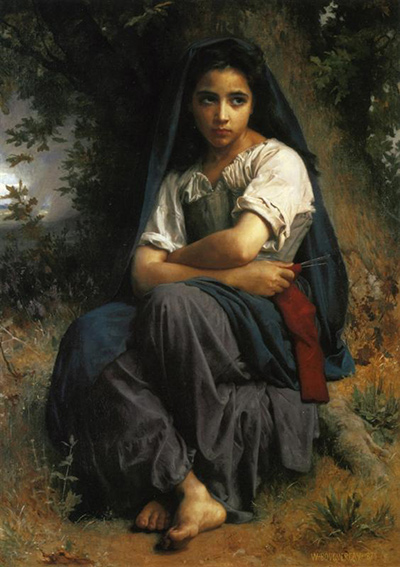The Little Knitter (1882) is a fine example of Bouguereau’s work, both in subject matter and painting technique.
The symbolism is apparent, the bare feet of the young woman suggesting that she is impoverished. The wistful look upon her face is filled with wondering, and causes the viewer to wonder also: why is she so poor?
The needles of the knitting in her hand point to somewhere outside the painting, indicating that the cause of her poverty lies in circumstances beyond her control.
The red of the knitting yarn in contrast to the blue of her petticoat suggests that her life has involved much suffering. She looks comfortable upon the tree trunk that forms her seat; perhaps it is a favourite haven?
In the background, the autumn wood indicates that change is inevitable. The light on the left of the image symbolises the subject’s adolescent awakening.
She won’t always be young and beautiful, and will have to find another way to live. Bouguereau’s rendering of every surface is meticulous; the clean linen and marmoreal skin, the blue and purple draperies, and the blended browns and greens of the forest. The painting is a poem of colour and form, and a comment on the sadness and brevity of life.
William-Adolphe Bouguereau (1825-1905) painted in the tradition of the French Academy, that is, depictions of moral subjects, of beautiful young women and innocent children, and scenes from mythology.
His paintings The Wave (1896) and the Birth of Venus (1879) typify this style, pictorial schema depicted realistically yet assembled to create scenes of the fantastic and the supernatural.
For example, the wings of his cupids are realistic as if copied from actual birds, while Venus is a very solid, human female.
Bougereau was a technically excellent painter; his flawless renderings of soft flesh, strands of silken hair, shiny marble, glittering gilt and light-absorbing flower petals ensuring him many commissions from wealthy patrons.
Because of this attention to surface and concentration on emotional content rather than intellectual stimulation, his contemporaries dismissed his work as superficial. By the time of Bouguereau’s death, this tradition of painting had gone out of fashion. However, he had been a prolific artist and left over 800 paintings.




